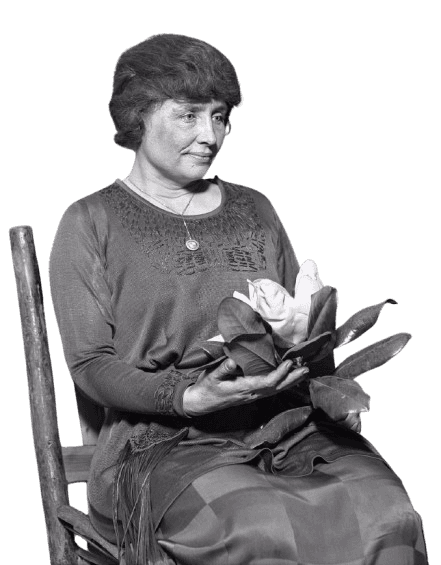Life and achievements
Early life
Helen Adams Keller was born on June 27, 1880, in Tuscumbia, Alabama, to Arthur Henley Keller and Catherine Everett Adams Keller. The family lived in a house called Ivy Green, constructed by Keller's paternal grandfather. She had four siblings: Mildred Campbell and Phillip Brooks Keller are her two full siblings from her parents, while she had two half-brothers from her father's first marriage.
Keller fell sick at the age of 19 months and became blind and deaf due to the illness. This disease is described as an acute congestion of the stomach and the brain, and the child likely had scarlet fever or meningitis. She could not speak, and her world became dark and quiet, and all she could do was make simple gestures to her family.
Anne Sullivan, a teacher at Perkins Institution and Massachusetts School for the Blind, came to the Kellers' home in March 1887. Sullivan then started working with Helen and taught her how to use signs to form words. Sullivan finally succeeded when she wrote 'water' on Keller's palm and poured water on his hand; in this way, Keller realized that things had names.
Keller's education was not confined to any particular school; he went to many schools, such as the Perkins Institute for the Blind and Wright-Humason School for the Deaf. She was a bright student, she learned to read by touching with her fingers and also developed other ways of expressing herself. Her education was completed at Radcliffe College; she graduated with honors in 1904.
Legacy
Helen Keller's accomplishments are numerous, and her mark is felt in many sectors of society and the perception of disabled individuals. Her unwavering efforts in the fight for the rights of disabled persons changed society's attitude and provided the foundation for subsequent improvements in their lives.
Keller wrote a lot and spoke a lot, and her works and speeches were on women's right to vote, workers' rights, and the right to peace. Her association with the Socialist Party of America and the formation of the ACLU proved her concern for social justice. Keller's work was not limited to her locality; she influenced the formulation of international policies and motivated many people to fight for the rights of people with disabilities.
Her biography, "The Story of My Life," is evidence of her strength and determination. These adaptations of her life story in plays and films, especially "'The Miracle Worke," have made her story live on, and the generations coming through are privileged to know it.
Keller was awarded many times in her lifetime, including the Presidential Medal of Freedom and induction into the National Women's Hall of Fame. She was born in Tuscumbia, Alabama, which is now a National Historic Landmark. She is commemorated every year on Helen Keller Day.
Milestone moments
Mar 17, 1887
Meeting Anne Sullivan
Anne Sullivan came into the Keller family in Tuscumbia, Alabama, in March 1887 to teach Helen Keller. Sullivan was a recent graduate of Perkins School for the Blind and had vision problems, so she was in an excellent position to understand Keller's situation.
In the beginning, she had many conflicts with Keller, as the girl was used to signing for herself in her simple manner. Sullivan introduced Keller to finger-spelling, a technique that involves spelling words into the hand.
The turning point was when Sullivan brought Keller to the water pump and pointed to the water while at the same time pointing to the word 'water' on Keller's hand. This understanding that objects had names changed Keller's world and was the start of her language development.
Jun 17, 1900
Enrollment at Radcliffe College
Helen Keller achieved a great accomplishment in 1900: She was admitted to Radcliffe College, which is part of Harvard University. This was historic since she was the first deafblind student admitted to the institution.
Hence, with Anne Sullivan helping her out in communication, Keller was subjected to the same academic challenges as any other student. She was academically gifted, penned down a lot, and studied for exams like any other student.
Keller was a very determined and intelligent woman. She graduated with honors in 1904 with a Bachelor of Arts degree. This achievement proved that disability did not hinder academic achievement and paved the way for other students with disabilities.
Mar 12, 1903
Publication of "The Story of My Life"
Helen Keller's autobiography, "The Story of My Life," was published in 1903 and introduced her life to the world. This book tells about her childhood, connection with Anne Sullivan, and efforts to learn language and communication.
The autobiography was well received by critics and sold in large numbers. It enlightened readers on the life of a deafblind person and featured Keller's inspiring success.
Many years after the publication of the book The Story of My Life," plays and films were developed based on Keller's life, especially the play and movie The Miracle Worker. These adaptations helped keep Keller's story alive and tell it to a new generation.
Oct 23, 1924
A spokeswoman for the American Foundation for the Blind said:
In 1924, Keller was appointed as the official representative of the American Foundation for the Blind (AFB), established recently. This position enabled her to speak nationally on behalf of people with visual impairments.
Keller's work with the AFB included extensive traveling, presentations, and fundraising. She also met with presidents and legislators to advocate for policies that would enhance the quality of life of persons with disabilities.
She has worked to ensure that the disabled receive funding for Braille libraries, vocational training, and other services. Keller's leadership in the AFB immensely helped advance disability rights in the United States of America.
